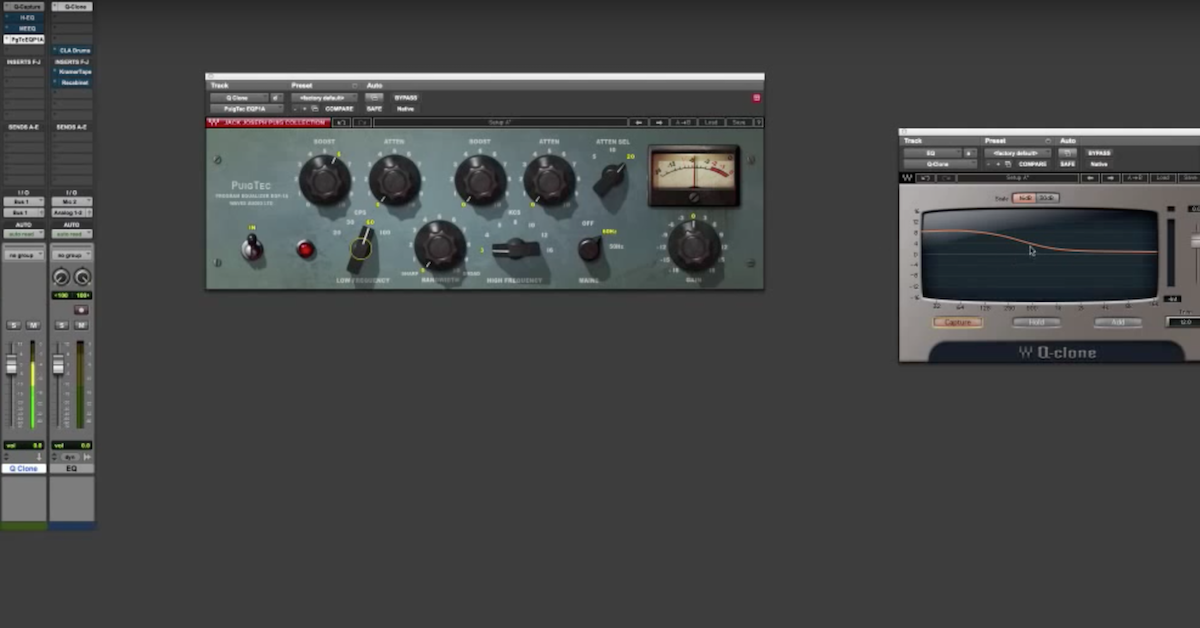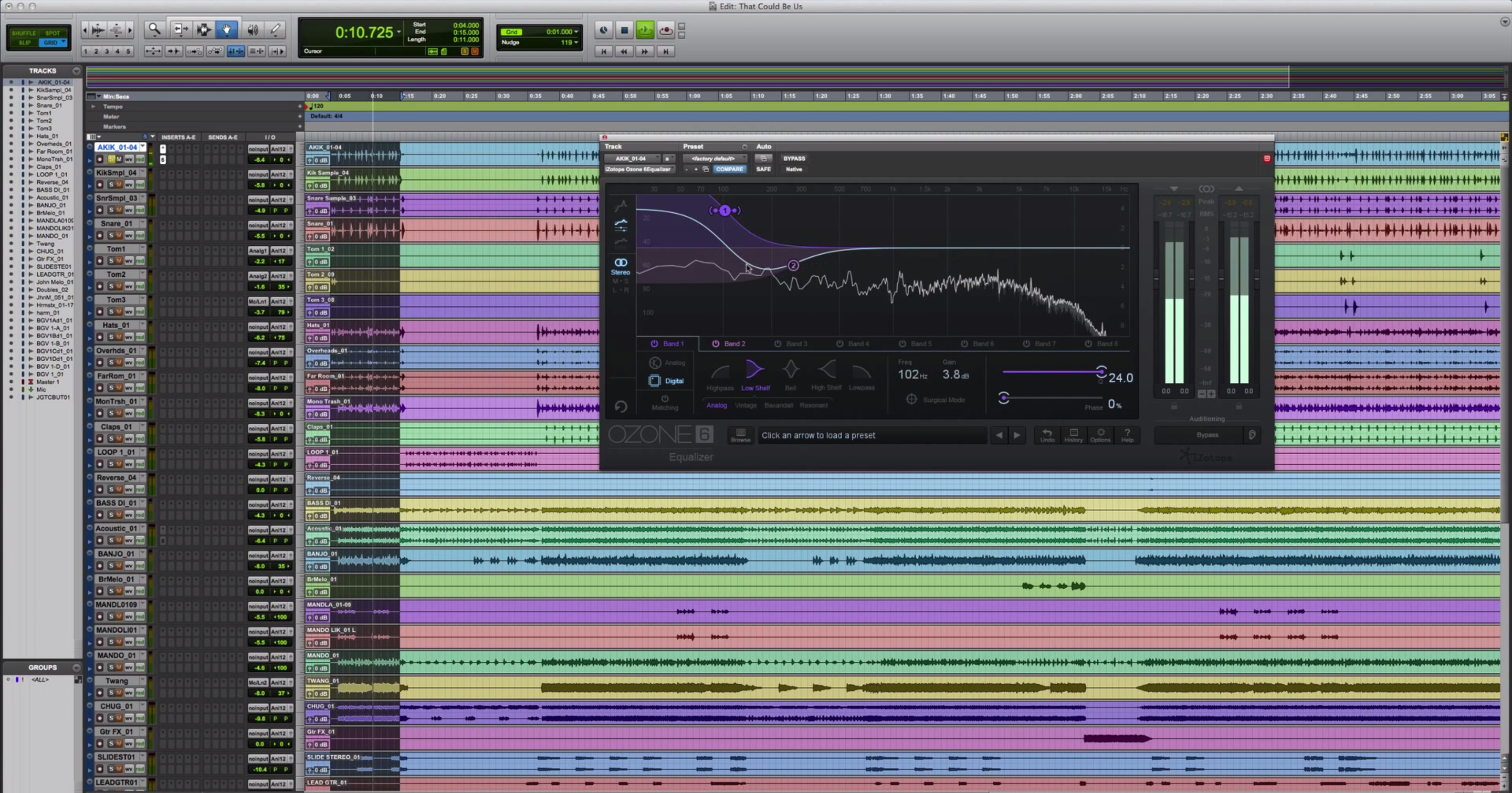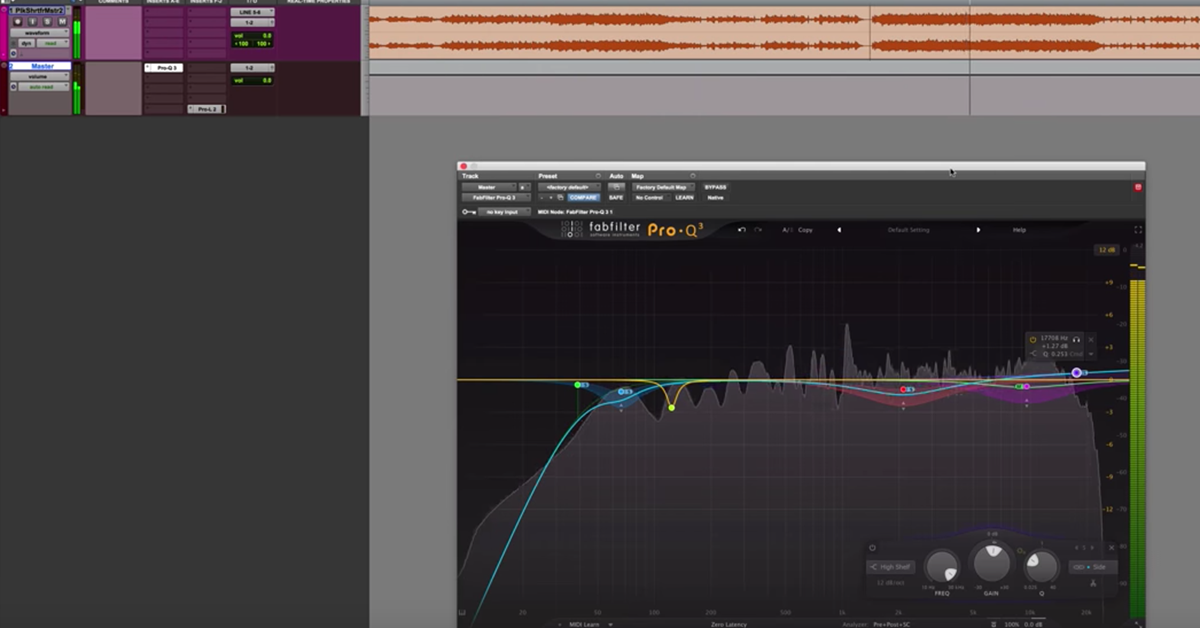14 Best EQ Plugins for Mixing (+ Mix Tips)
Article Content
Equalizers have long been one of the most important processors for audio engineers. They are essential tools for bringing the best out of each and every element of a mix.
The history of audio equalization is an interesting one: beginning with incorporation into telephone technology then becoming viable for use in sound for cinema, equalizers eventually made their way into broadcast and music recording. You’d be hard pressed to find a popular recording over the past 60 years that didn’t use an equalizer at some stage of production.
Here are some of my favorite equalizer plugins that I use when mixing.
1. UAD Manley Massive Passive
Modeled after (arguably) the greatest equalizer ever created, the Universal Audio Manley Massive Passive does it all, and does it well. EveAnna and the amazing team at Manley Labs certainly wouldn’t have signed off on this plugin otherwise. The behemoth tube-based hardware unit is a staple in studios the world over. It’s known for its versatility, degree of control and of course, its unparalleled sound quality. Universal Audio painstakingly modeled the hardware, and the result is a plugin with the same functionality and even more features — all at a fraction of the price. Don’t get me wrong, I certainly wouldn’t turn down a hardware Massive Passive if offered one, but it’s fantastic to be able to use multiple instances of this plugin in a singular session.
The faceplate may look intimidating, but don’t let that deter you from learning this plugin. It’s a two channel, four-band equalizer, so the left and right halves of the plugin are exactly the same. Each band has controls towards the top that allow you to either boost or cut and choose between shelf or bell. Each of the bands allow you to choose the frequency in steps. The lowest band ranges from 22 Hz to 1 kHz, band two from 82 Hz to 3.9 kHz, band three from 220 Hz to 10 kHz, and the highest band from 560 Hz to 27 kHz (well above any non-mutant human’s range of hearing, but still great for adding air to program material). You are also able to adjust the bandwidth for each band and of course control how much to boost or attenuate. In the center of the Massive Passive, you can add or subtract gain, link or unlink the two channels and apply low-pass or high-pass filters.
Mix Tip
It’s hard to decide what advice to leave you with here, because the Massive Passive is so musical-sounding and therefore useful for so many applications. If I had to pick one characteristic to focus on though, it’d have to be how it “opens up” the entire mix when placed on the stereo buss. Once you’re somewhat happy with how your mix is sounding, insert it (post any compression) and boost using the low and high shelves (perhaps at 100 Hz and 16 kHz) to add a “smiley face” curve to your entire track.

2. FabFilter Pro-Q 3
For more surgical work, and when you need more modern features, I can’t think of any equalizer more effective than the FabFilter Pro-Q 3.
This plugin isn’t something I reach for when I’m looking to add coloration or character to my tracks, it’s more for precise “fixing” of unwanted resonances or harshness, and occasionally to add a subtle boost wherever needed. The Pro-Q 3 really does everything you would hope a “digital” style equalizer can do. While the Pro-Q 3 is filled to the brim with useful capabilities, some of my favorite and most used features include:
- M/S (Mid/Side) mode allows you to treat the center separately from the sides, which is great for stereo buss work.
- It has perhaps the most beautiful spectrum analyzer I have ever seen and used. The “spectrum grab” feature is excellent for determining when there is potentially too much information taking place at any one area of the frequency spectrum.
- Dynamic EQ mode allows the user to only apply boosting or attenuation when the plugin detects signal over a set threshold.
Mix Tip
Use the dynamic EQ mode on vocals for de-essing. When I de-ess, I find that it’s better to spread the workload across multiple plugins for maximum transparency. Because the dynamic EQ mode allows the Pro-Q 3 to adapt to your material (only removing what you want, when you want) it’s perfect for de-essing. I’ll use the spectrum analyzer to determine where the harsh esses are occurring in the frequency spectrum, create a band, set it to dynamic EQ mode, adjust the bandwidth and amount of attenuation to taste and it’s done!
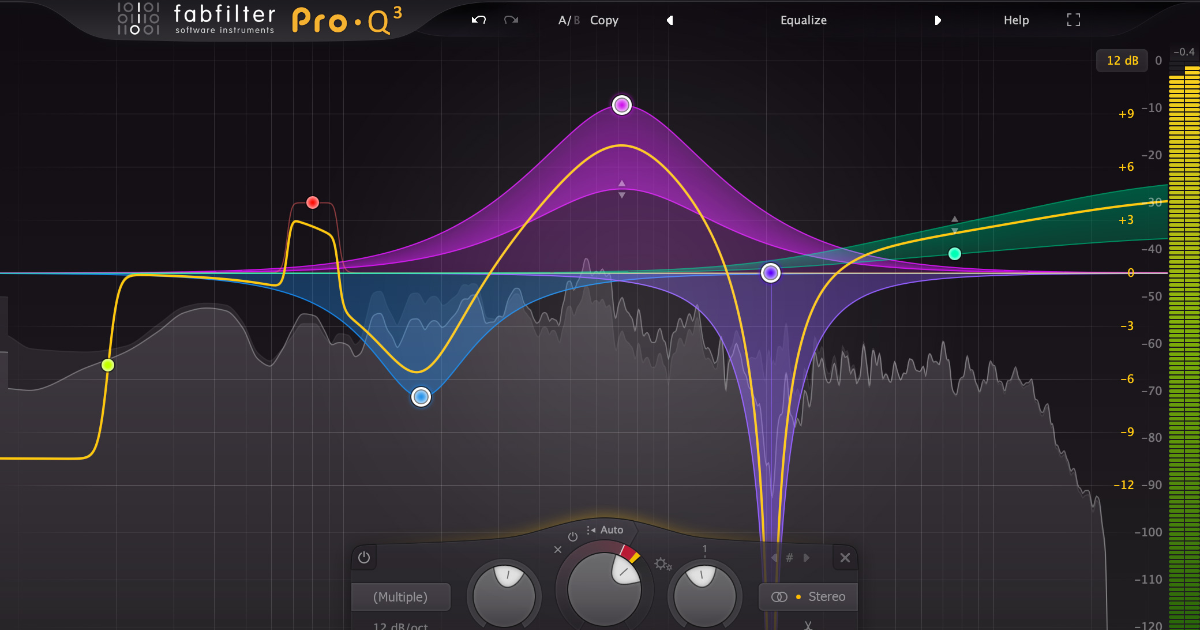
3. Whatever Pultec EQP-1A Emulator You Can Get Your Hands On
Built and introduced in 1951 by Ollie Summerland and Gene Shank in my home state of New Jersey, the EQP-1A has become a studio legend due to its warmth, clarity and beautiful top end. Originally used widely by the broadcast industry to add a final touch to inferior-sounding program material, the passive, all-tube Pultec eventually found its way into recording studios and has been used on thousands of records since.
One of the unique features of the Pultec EQP-1A is that it can simultaneously boost and cut at the exact same frequency. “Why would you want to do this? Wouldn’t they cancel each other out?” you might ask. To put it simply, the boost control has a bit more gain than the attenuate control, and the frequencies are slightly different. You can see in the beneath illustration (created by running pink noise through the Universal Audio Pultec EQP-1A) that with the boost and attenuation dials both set to ten at a frequency of 60 Hz, the resulting sound has a pronounced midrange dip when compared to the original. This makes the Pultec a go-to option when trying to balance kick drum and electric bass. If you want your kick to sit beneath the bass, it’s advisable to insert the plugin on the kick drum, boost somewhat drastically at the preferred fundamental (60 Hz is a nice starting point) and then use the attenuator to scale back the effect. Then, apply a Pultec to the bass, and try to do the opposite, attenuating where you had previously boosted. This is surely not a fool-proof method to establish a healthy kick/bass relationship but will generally serve as a good starting point.
There are many great emulations of the EQP-1A, including offerings from the aforementioned Universal Audio, Waves, IK Multimedia and more.
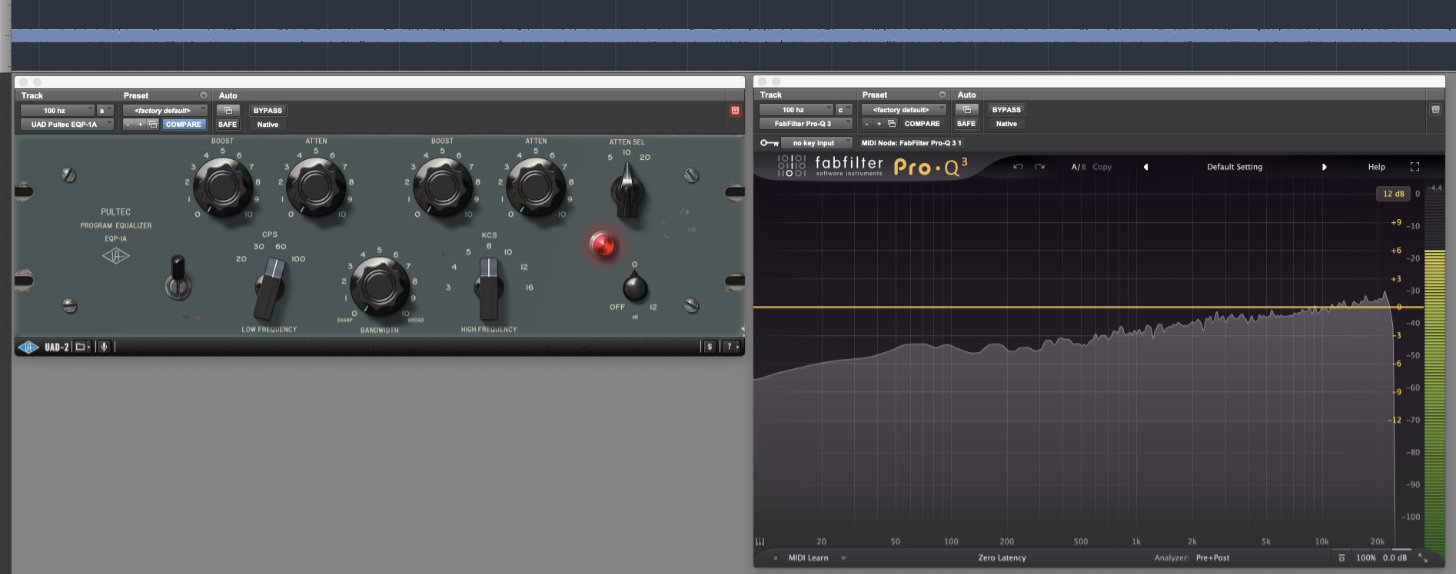
Pultec spectral analysis: no change
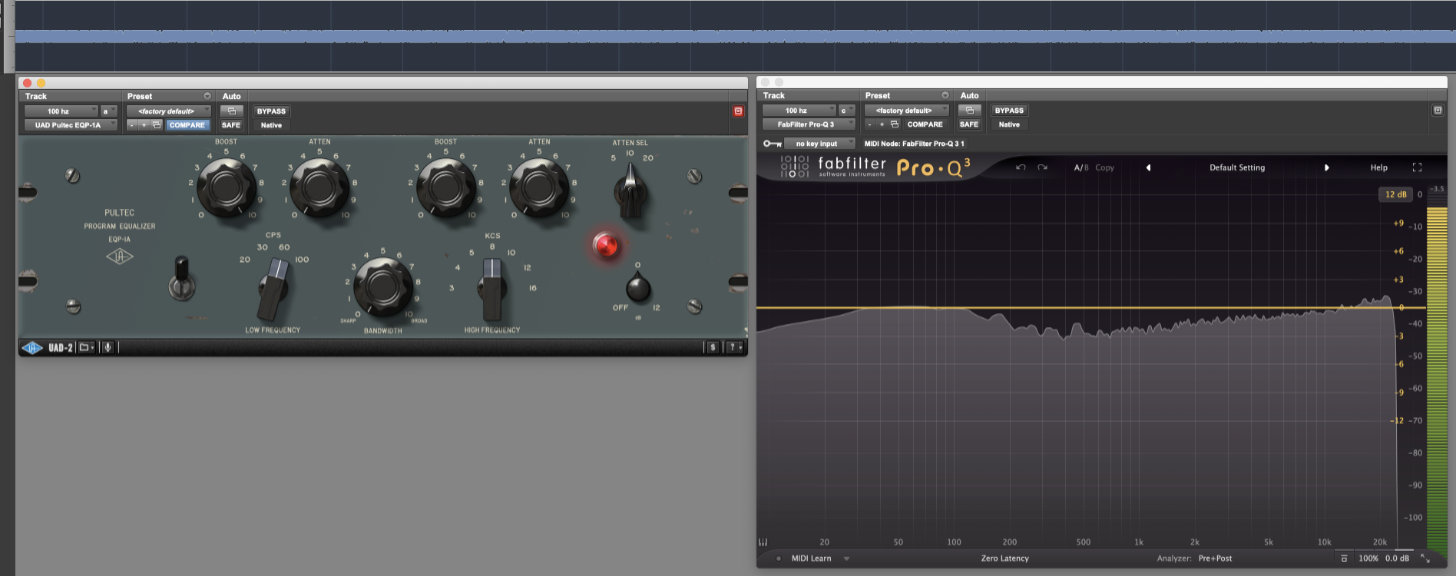
Pultec spectral analysis: boost only
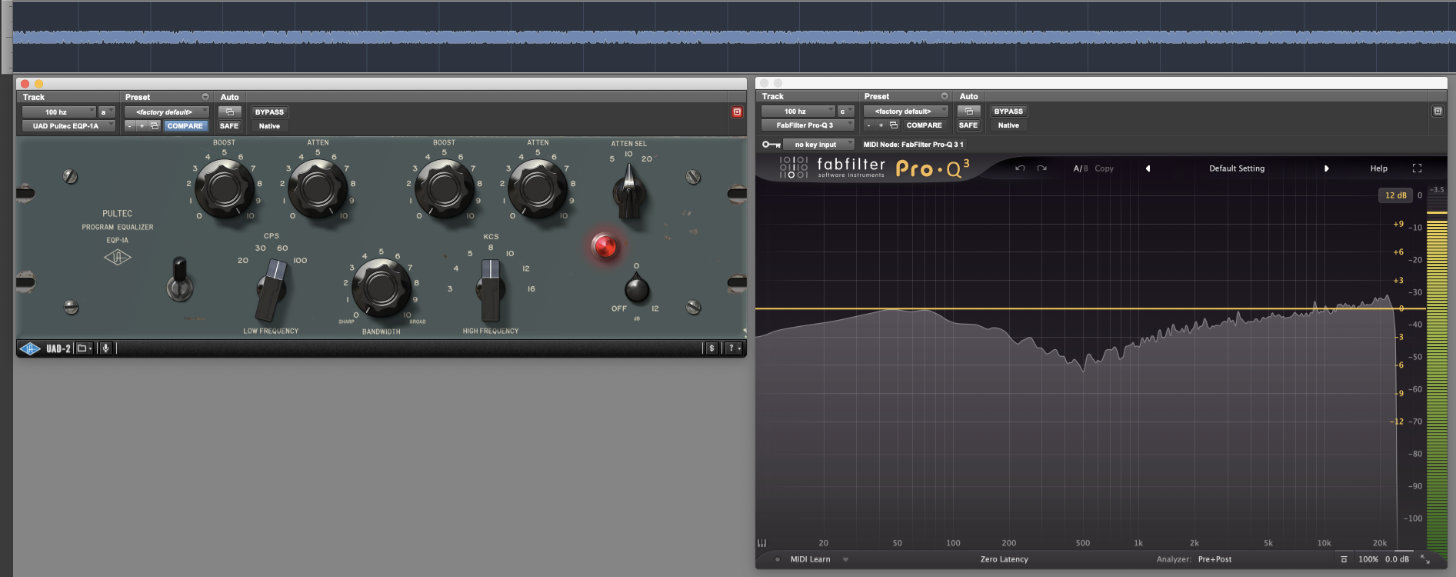
Pultec spectral analysis: boost and attenuation applied
Mix Tip
Try using the Pultec as it was originally intended, as a finishing touch on your stereo buss. Sometimes just a subtle boost at 10 kHz or 12 kHz is exactly what a mix needs to sound more open and clearer. Use the Pultec in this way just before the final limiter if your mix is lacking top end sparkle. Additionally, thin-sounding mixes can benefit from a small boost at 60 Hz or 100 Hz.

4. iZotope Neutron EQ and Ozone EQ
Part of modern mixing is getting productions to be competitively loud. This goes beyond compression — it means removing what doesn’t need to be there (particularly in the low end) and emphasizing what does. These two plugins help identify what those frequencies are, and can boost or attenuate with precision and mostly transparent sound quality. Excessive low frequencies especially can eat up valuable headroom, and using a high-pass filter or well-placed notch filter can go a long way in preserving headroom, allowing one to push the volume of the mix louder without compromising dynamic range and tonality. iZotope is known for making practical, flexible, forward-thinking software and these two equalizers that can be found within the Music Production Suite are no exception. I often use them for ‘pseudo-mastering’ purposes when I’m tasked with delivering loud, modern-sounding mixes.
Mix Tips
The Neutron 3 equalizer is a 12-band powerhouse complete with a dynamic EQ mode, impressive sidechain capabilities and plenty more useful bells and whistles. A fascinating feature I use often is the frequency masking meter. Essentially, it tells you where there may be frequency masking between the different elements of your mix. For example, masking is common between kick and bass, or keyboards and guitars. Even more impressive is the inverse link option which allows you to work across multiple instances of Neutron 3. With this feature, you can boost at a specific frequency range on one instance, and a second instance of the plugin will attenuate at that same frequency range automatically. This works wonders, especially on large sessions where a lot of frequency masking may be present.
Ozone is better suited for in the box mastering and stereo buss work. I often use the mastering assistant feature to see what the plugin suggests is working well and not so well in my mixes, frequency-wise. Sometimes I’ll disregard what mastering assistant recommends, other times I’ll consider the recommendations and make slight changes within Ozone. Occasionally I’ll see where in the frequency spectrum Ozone suggests I make fixes, and then use my mastering-grade hardware equalizer from High Voltage Audio to make adjustments at those specific frequencies.
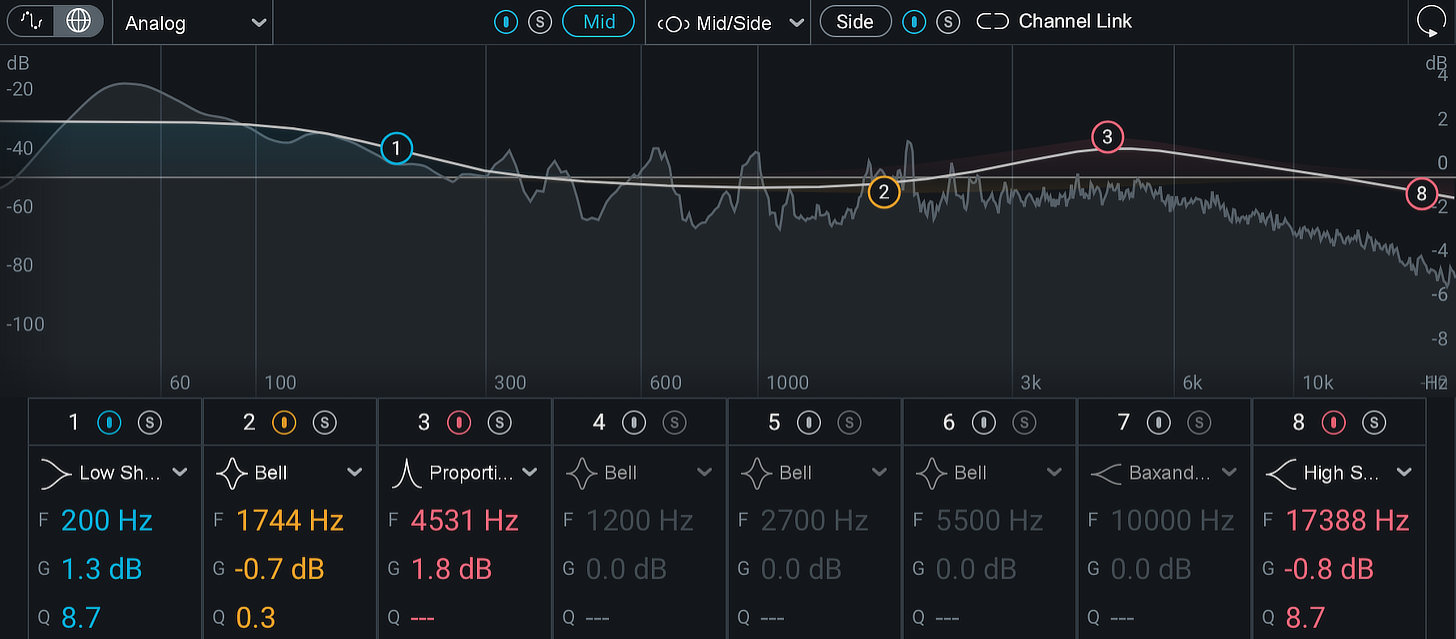
5. Soundtoys Sie-Q
The Sie-Q is modeled after the Siemens W295b, and is one of the equalizers I reach for when I want to add character to tracks.
It’s pretty simple to use, featuring the ability to boost or cut in the lows, mids, and highs. While we as engineers are first and foremost focused on sound quality, there is something to be said about how many of the plugins from Soundtoys feel like, well, toys. Their user interfaces have big, chunky knobs that you can almost hear make a satisfying click when you make a change. That said, the Sie-Q sounds lovely and due to its simple controls, I can generally dial in a good sound with it within a matter of seconds.
Mix Tip
The plugin was designed to retain the saturation characteristics of the original hardware, and you can push the unit by turning up the drive parameter. The plugin automatically adjusts the output level, preventing it from getting too high as you apply more drive.

6. The Waves API Collection
The Waves API collection includes the API 550A 3-band EQ, API 550B 4-band EQ, API 560 graphic EQ and API 2500 stereo compressor. These are all emulations of famed hardware units from Automated Processes Incorporated (API for short). Due to slightly differing functionality, the 550A and 550B EQ units serve their own purpose, but I have found them both to have a clear, open-sounding top end, punchy midrange and round, full low end. The 560 is a graphic equalizer and, personally speaking, gets the most usage out of the three. I often use the clarity of the 16 kHz band to enhance vocals, acoustic guitars and drums.
Mix Tip
Try limiting yourself to using only these equalizers when mixing. API console equalizers are wonderful — there’s just something special about the way they can “glue” a mix together. No equalizer is perfect for every single application, but if you’re in a position where you can challenge yourself on a mix by only using one set of equalizers, try using these emulations of the wonderful sounding units that have been used to sculpt the sounds of thousands of records.
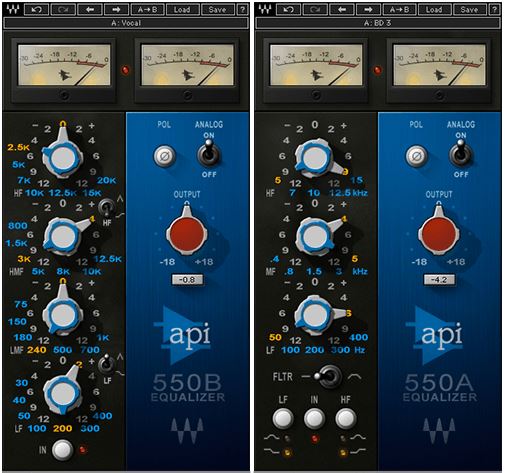
7. Mäag Audio EQ4
The legendary Mäag hardware was used to shape the vocals of artists including Madonna, Snoop Dogg and the Black Eyed Peas. You’ll realize why almost instantly after inserting this beautifully blue equalizer on a vocal track and experimenting with the patented air band, which offers a shelving boost at 2.5 kHz, 5 kHz, 10 kHz, 20 kHz, and even 40 kHz. While 40 kHz is well above the range of human hearing, I often use this setting to add, well, air to a variety of sources.
Mix Tip
While you might be tempted to ignore all that this EQ has to offer and use it simply for the air band, I find each of the bands to be musical, clear and useful for a variety of applications. I find myself utilizing this equalizer on kick and snare drums, bass, subgroups and even the stereo buss.

8. Amek EQ 200
Based on legendary equalizers from the 1970s, Plugin Alliance and Brainworx have created an incredibly versatile, precise and transparent equalizer in the Amek EQ 200. This plugin is inspired by the GML 8200 Parametric Equalizer and several vintage EQs from Sontec. The Class-A, 5 Band GML 8200 has long served as one of the industry standard parametric equalizers for mixing and mastering. It’s known for its surgical precision, stunning sonic clarity and, to a lesser extent, its multicolored knobs. Meanwhile, hardware by Sontec has been referred to as “holy grail” mastering equalizers, and has also been used on countless records. The Amek incorporates the functionality and design of each of these esteemed units, with several extra plugin-only tools including variable high and low pass filters, mid/side capabilities and auto-listen features. The result is a monstrous equalizer that sees a lot of use on individual tracks, subgroups, the stereo buss and even during mastering.
Mix Tip
Use the Amek on the stereo buss in mid/side mode for an improved sense of space and definition. I often use this mode when I’m about 90% finished with a mix. I’ll make decisions and moves that allow elements that sit straight up the middle (vocals, kick, snare, bass) to achieve greater separation from those that are hard-panned (double-tracked guitars, overheads, certain percussion).Even when used in traditional stereo mode, the Amek is so effective for carving out space.
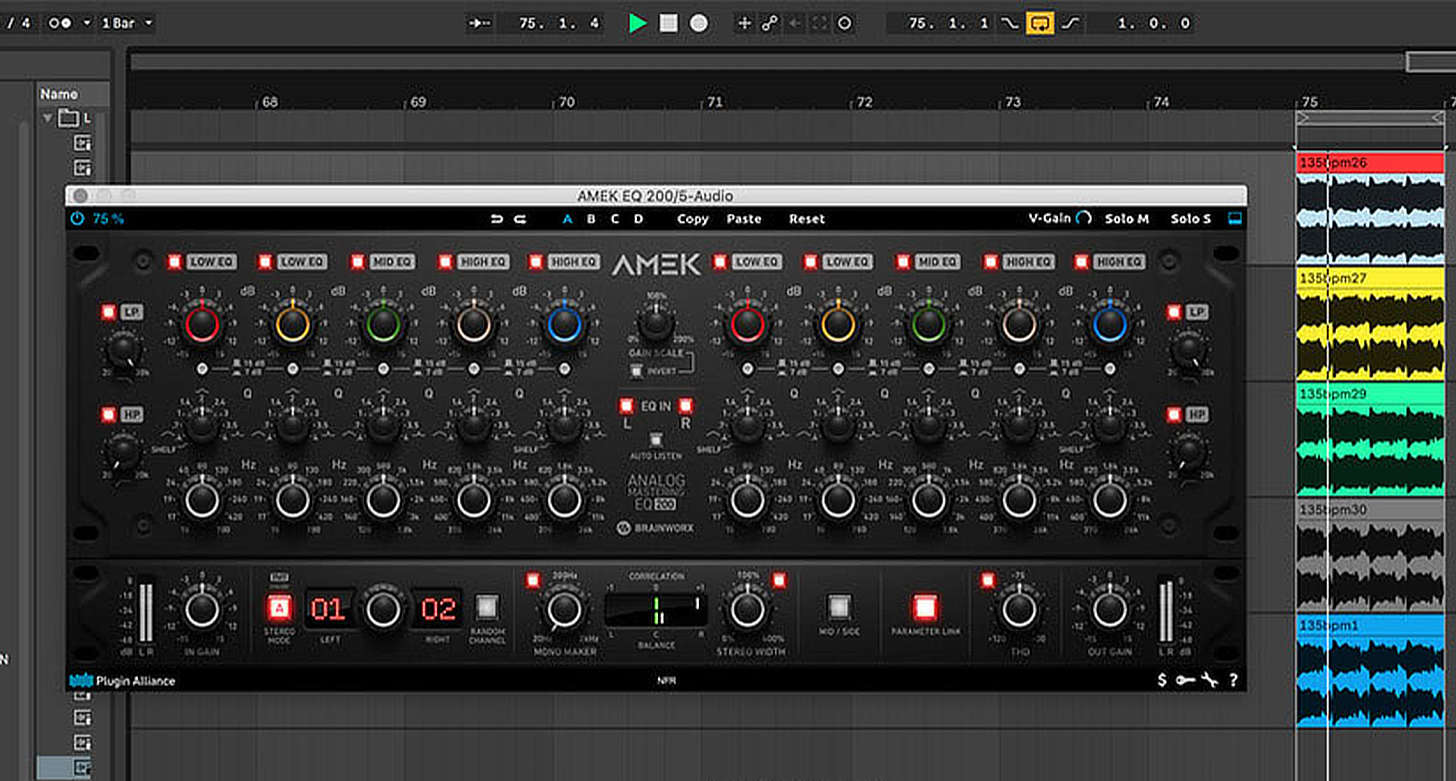
9. UAD/ Plugin Alliance Dangerous Music Bax EQ
Peter Baxandall is one of the most influential audio engineers of all time. During the Second World War, Baxandall worked for the Telecommunications Research Establishment in the Circuit Research Division. Fortunately for the rest of us, he shared the fruits of his labor with the world, and was largely responsible for the the bass and treble knobs found on stereos — his smooth, musical “tone control” circuits found their way into countless consumer audio devices. In 2010, Dangerous Music released the instant classic BAX EQ hardware unit, which has since been emulated by Brainworx and Universal Audio. The BAX isn’t a surgical equalizer, rather an open and sweet-sounding unit ideal for adding a finishing touch to a nearly completed mix or master. It’s pretty simple to use, featuring low & high frequency filters and low & high frequency shelves that can be used to boost or cut.
Mix Tips
For final sweetening duties — let’s say adding a couple of dB at 7.1 kHz and above and at 54 Hz and beneath — try placing the Bax directly before your final limiter. Conversely, see if you can get away with using only the Bax, a compressor and a limiter on your stereo bus. Sometimes less is more, and I find the clarity and openness of the BAX can do the work of an exciter and/or stereo enhancer, all without introducing phase issues.
10. UAD Chandler Limited Curve Bender
Based off the legendary TG12345 console that helped shape the sound of Pink Floyd’s “Dark Side of the Moon” and “Abbey Road” by The Beatles, the Curve Bender from Softube/Universal Audio takes the mojo of the classic desk and adds some unique features that make it ideal for both mixing and mastering. The original EMI TG12345 desk EQ offered nine fixed filter points. The Chandler Limited Curve Bender plugin features an astounding 51, plus it offers even more gain options, a more flexible bandwidth/Q control, mid/side capability and high & low‑pass filters. Don’t let the abundance of knobs and switches intimidate you — once you get the gist of how the Curve Bender functions, you’d be surprised at how easy it is to dial in a vibrant, clear sound.
Mix Tip
The midrange color of this equalizer is distinct, with a somewhat aggressive, yet still musical timbre. If your tracks are lacking in bite and character in the mids, don’t be afraid to boost liberally in the 1 kHz to 8 kHz range. I’ll employ the Curve Bender in this way on snare drum, guitars, vocals, electric bass and even subgroups.

11. Waves V-EQ Collection
Modeled after two separate Neve equalizers that have been heard on countless records, I’ve been employing the Waves V-EQ3 and EQ4 for well over a decade. I enjoy them for their relative ease of use and character-rich qualities.
The V-EQ3 is better for more broad-stroke EQ moves. It features a high-pass filter with 7 cutoff frequencies, a low shelf with boost/cut and 5 corner frequencies, a midrange frequency bell with 10 resonant frequencies and a high shelf with boost/cut at two points: 10 kHz and 12 kHz.
The V-EQ4, which I find to be a tad more surgical, is different in that it reduces the number of high-pass cutoff frequencies to 5, adds 5 lowpass cutoff frequencies and includes two bell responses (peak/notch) which, similar to the V-EQ3, have 10 resonant frequencies. It also features low and high shelving EQs, each offering 5 different corner frequencies, but also includes a button which converts them to bell responses.
Mix Tips
Despite being a bit older than most plugins in the roundup, I still reach for the V-EQ3 and V-EQ4 for a number of tasks, and am quite fond of the silky quality that their high shelves impart into vocals. Be careful though, as they can each cross into harsh territory when pushed too hard.

12. Slate Digital Infinity EQ
Slate Digital is known for making authentic sounding plugin emulations of actual hardware units, but the company has also created some very useful tools with more modern designs and feature sets. The Infinity EQ is a super slick, pristine-sounding equalizer packed with state-of-the-art controls. The GUI looks like a dashboard of a spaceship with vibrant colors and smooth visual feedback, and the mid/side mode helps to make subtle changes to enhance the stereo field.
Mix Tip
One of my favorite features of more modern-inspired equalizers is the band solo function for critical listening, and that feature is executed perfectly on the Infinity EQ. When trying to pinpoint unwanted frequencies and whistle-tones, the band solo function helps me to quickly sculpt the tone of individual tracks, subgroups and the stereo buss.
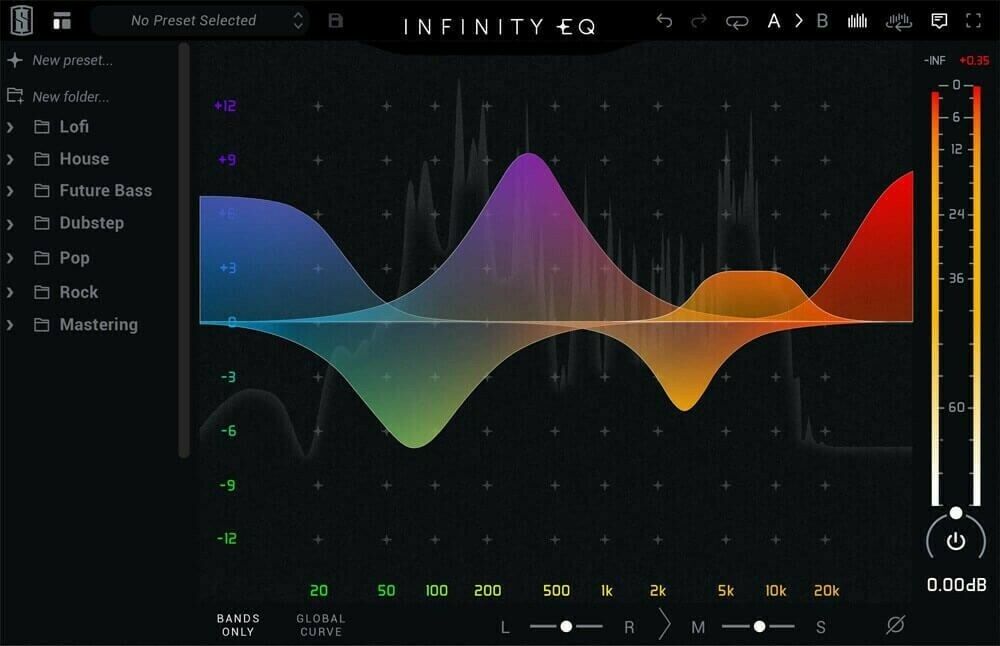
13. Millennia NSEQ-2
Available from Plugin Alliance, The Millennia NSEQ-2 is a sought after parametric EQ used in many of professional studios and mastering houses. It features a twin topology design (more on that shortly) and pure class A transformerless circuitry resulting in a mostly transparent sound — great for subtle enhancing of program material.
Users can benefit from gorgeous-sounding low and high shelves, each with 6 available frequencies, as well as 2 midrange bands with variable Q controls. Making the NSEQ-2 even more versatile is the ability to work in mid-side mode, which can help the user to solve problems with clarity, width and harshness relative to the stereo field.
Mix Tip
The Millenia twin topology design, which includes both tube and solid state signal paths, makes this plugin a supremely versatile workhorse equalizer — users can opt for the warmth and width of the triode 300 V vacuum tube, or the clarity and punch of an all discrete J-FET solid state signal path; both have their place for certain types of program material.

14. Your Stock DAW Equalizer
All of the aforementioned plugins are fantastic, and they are far more likely to see use than the stock plugins that come with the DAWs that I currently use the most for mixing (which are Logic Pro and Pro Tools). However, don’t let this deter you from making do with what you’ve got. Equalizers may come in different shapes and sizes along with differing capabilities, but all serve a similar purpose: to get your tracks to “play nice” with each other. It’s better to learn the basics on a simple stock equalizer than to feel overwhelmed and overdo the equalization with a feature-laden third-party plugin.
Logic Pro especially comes with an impressive array of equalizers straight out of the box. There’s the Vintage EQ Collection which features Console (Neve-inspired), Graphic (API-inspired) and Tube (Pultec-inspired) equalizers. Each of them offers great sound quality and functionality. Use them to add some vintage flavor to your tracks when producing or mixing within Logic Pro.
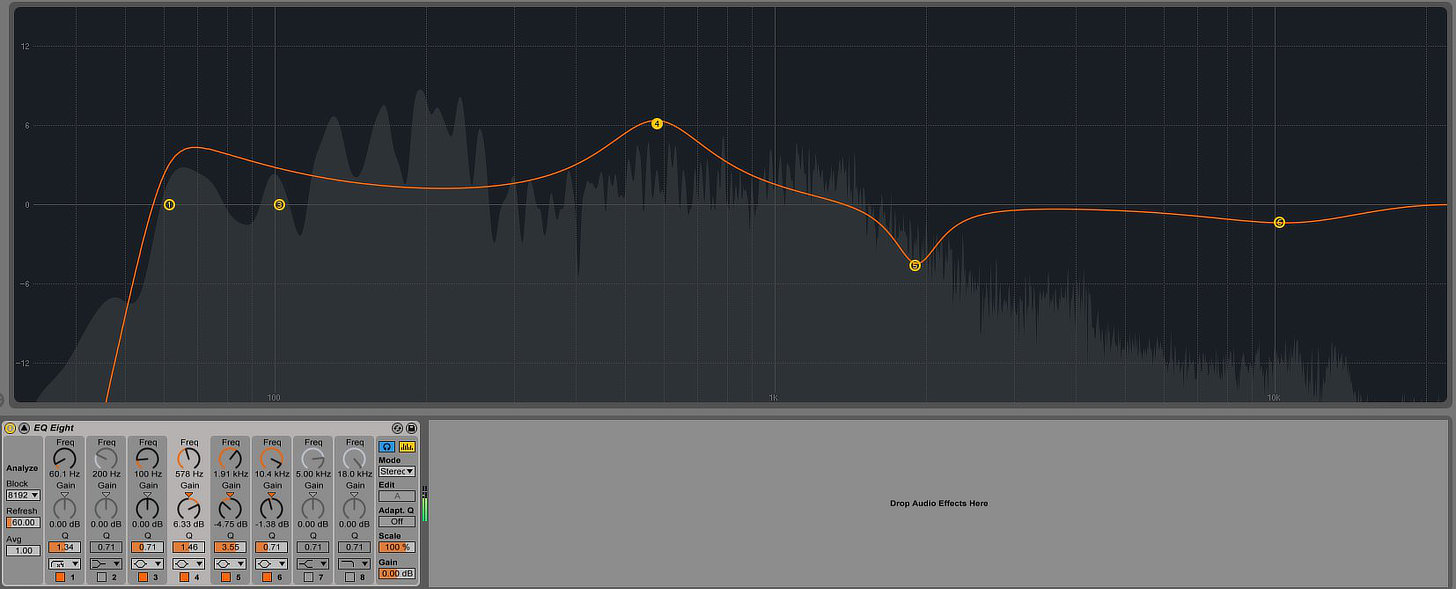
Ableton Live’s EQ8, an example of a stock EQ




